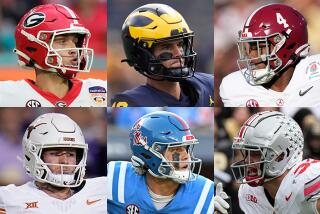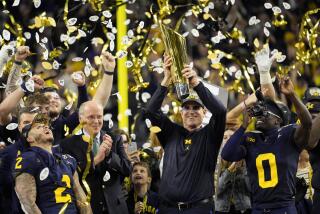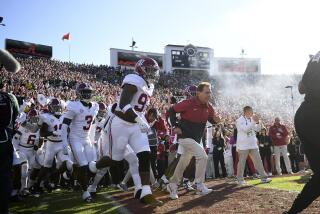ANALYSIS : Who Is No. 1? Miami, Because It Beat Irish, Who Beat Colorado
So who is No. 1?
Miami, the pollsters will undoubtedly decide.
But Bobby Bowden was probably right Monday when, after his Florida State team routed Nebraska, 41-17, in the Fiesta Bowl, he said the Seminoles were, at the end of the season, the best team in America.
In other words, could anyone else who played Monday have beaten Nebraska, a 10-1 team, by 24 points? It didn’t seem so.
Unfortunately for Florida State, the national championship isn’t awarded to the best finisher, as it would if a playoff format were in place. Under the bowl setup, the entire season is reviewed by the pollsters, and on that basis Miami (11-1), a 33-25 winner over Alabama in the Sugar Bowl, seems the winner of the 1989 national championship.
That would be Florida State’s reward today, had it not stumbled badly in September. The Seminoles lost their opener to Southern Mississippi, 30-26, and their second game to Clemson, 34-23. After that, they won nine in a row, including back-to-back victories over Auburn and Miami and a smashing win over Nebraska on Monday.
Miami (11-1) lost in midseason to Florida State, 24-10, which means the Hurricanes aren’t even the champions of Florida. And Miami’s schedule wasn’t exactly fearsome, what with Cincinnati, Wisconsin, San Jose State and San Diego State in the lineup. But Miami’s main claim to No. 1 is nonetheless a strong one: the Hurricanes thumped Notre Dame, 27-10, in the last game of the regular season.
And on New Year’s Day in Miami, even though Notre Dame broke up Colorado’s dream of an undefeated, national championship season, the Irish can’t claim the national title. Despite Notre Dame’s having the toughest schedule of all the teams playing on New Year’s Day (based on number of opponents--eight--with winning records), Miami had beaten the Irish decisively. Case closed.
As the day began, there were eight teams whose partisans--in the event of a Colorado loss to Notre Dame--could come up with arguments, ranging in strength from weak to solid, for claims on a national championship. They were: Alabama (10-1), Arkansas (10-1), Florida State (10-2), Miami (10-1), Michigan (10-1), Nebraska (10-1), Notre Dame (11-1) and Tennessee (10-1).
Only Colorado (11-0), the lone unbeaten, was in charge of its destiny. Everyone else needed a Notre Dame victory in the Orange Bowl, and a combination of events--some of them bizarre--in other bowls.
For example, given Colorado’s loss to Notre Dame, what if Alabama had routed Miami in the Sugar Bowl? Would that have given the national championship to Alabama? Oh, really? You’d give it to the team that beat the team that beat Notre Dame, but lost to Auburn and didn’t even win the state championship of Alabama?
Wait a minute. Doesn’t the same standard apply to Miami, which didn’t win the championship of Florida?
No, because Miami beat the defending national champion, the class team of college football, and lost only one game, the same as everyone else under consideration.
Here’s another troublesome scenario: What if Michigan had bombed USC and Alabama had beaten Miami? Would that have made Michigan the national champion? Do you forgive Michigan for being done in by two Raghib Ismail kick returns in September for its only loss (to Notre Dame, 24-19)?
Or what about this one: Nebraska routs Florida State (which beat Miami) in the Fiesta Bowl, and Miami loses big to Alabama? Is Nebraska, which had one of the weakest schedules of the group but which lost only to Colorado, 27-21, the national champion?
None of that happened, of course, and it all came down to two facts: Colorado showed it wasn’t in Notre Dame’s class, and Miami already had.
More to Read
Go beyond the scoreboard
Get the latest on L.A.'s teams in the daily Sports Report newsletter.
You may occasionally receive promotional content from the Los Angeles Times.










